The Difference Between Hawaiian Shaved Ice And Italian Ice, Explained
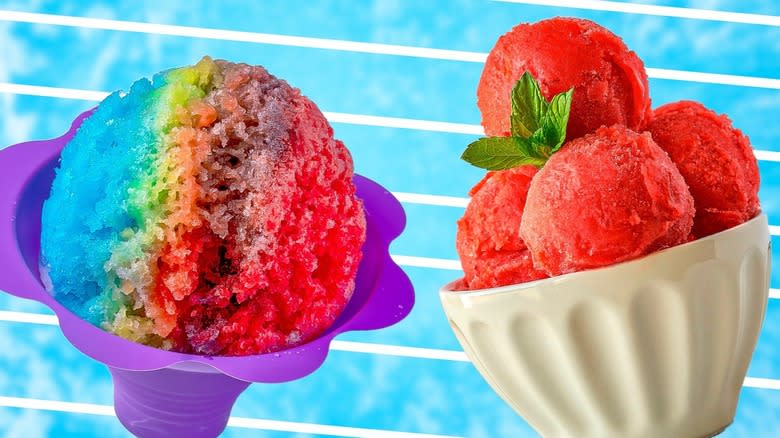
China may be able to claim the credit for inventing the original icy dessert, as a combination of snow, milk, and rice was first made there around 200 B.C. But today, frozen treats come in many different varieties all around the world, with the ice-based Hawaiian and Italian versions being some of our favorites. Since you'll find both types in the U.S., it may be difficult to distinguish between the two at first glance. After all, they're both sweet, ice-cold, and ultra-refreshing on a hot day.
Both iced treats started off as unique recipes in other countries and were adapted by immigrants in the U.S. to become the versions that we know today. So, where does the difference lie? It all comes down to the ingredients required, the methods used to make these two desserts, and the unique story of how each one came to be. Italian ice typically has a smoother texture, and may initially remind you of other scoopable treats like sorbet and sherbet. Hawaiian shaved ice, however, looks like a delicious pile of sweet goodness and offers more room to get creative with toppings.
Read more: 25 Best Ice Cream Brands Ranked
What Is Hawaiian Shaved Ice?
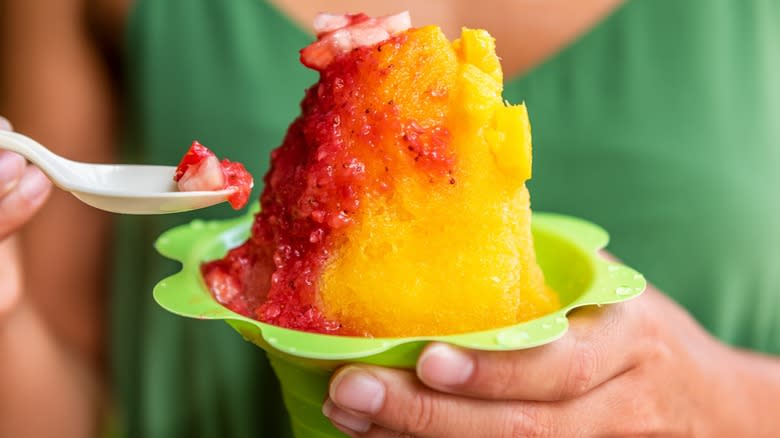
Hawaiian shaved ice (which is called "shave ice" on the Islands) is exactly what it sounds like: Ice that has been shaved off a big block so that it melts in your mouth. It's then topped with sugar, fruit juice, syrups, and occasionally other fun ingredients for flavor, which typically refrain from sinking straight to the bottom because of the ice's texture. It's cold, sweet, sticky, and comes in a wide array of colorful, fruity flavors. Typically, you'd eat it with a spoon out of a big cup.
The roots of Hawaiian shaved ice start with Japanese immigrants, who came to work on sugar plantations on the Islands starting in the 1800s. Also called kakigori, the treat as we know it today likely originated in a Japanese town in 1869 and quickly caught on in Hawaii. Initially, plantation workers would eat it to cool off after a long day in the sun, but by the 1900s, these immigrants began selling shaved ice out of their own shops.
Movie theaters also hopped on the trend and started offering the treat as well, and soon enough the dessert spread to the mainland U.S. New Orleans became the first city to use a block ice shaver in 1934. But today's most iconic Hawaiian shaved ice shop, Matsumoto Shave Ice, launched in 1951, putting this dessert on the map as a sought-after tourist draw.
What Is Italian Ice?
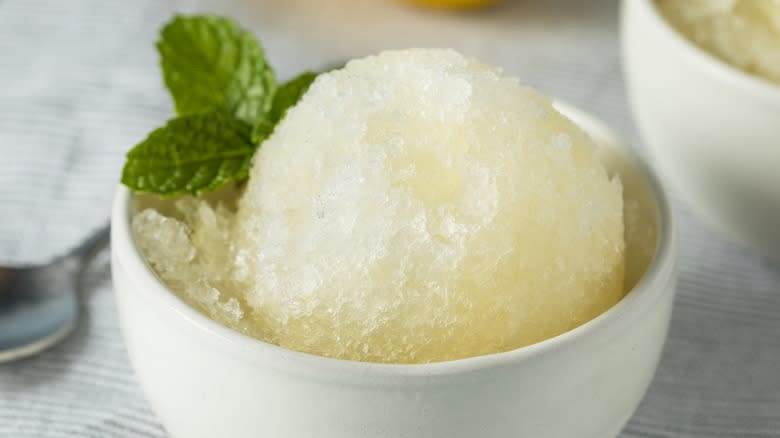
As opposed to the rougher texture of Hawaiian shaved ice, Italian ice (sometimes called Italian water ice) is smoother and more compact. It's composed of similar ingredients, including a sugary syrup and fruity components like juice or purée, but these components are thoroughly mixed and frozen together, creating a more uniform consistency. At first glance, you may mistake it for sorbet or sherbet, as it's often served in scoops on a cone, or in a cup with a spoon. Just like the Hawaiian frozen treat, this Italian one is sweet and colorful and can come in a wide range of flavors. Unsurprisingly, we'll need to travel to Italy to uncover the origins of this icy dessert.
It started out as granita, which is an Italian frozen treat that is made using a unique scraping technique to create an icy base with a flaky texture. While granita was invented as early as the 1500s in Sicily, Italian immigrants were the ones who morphed it into water ice in the 1900s when they came to the East Coast -- specifically, a woman from Sicily allegedly first started making the treat in her New Jersey home. It soon sprouted in nearby New York areas like Staten Island, Queens, and Brooklyn, and eventually became so popular that it traveled across the country.
Making Hawaiian Shaved Ice Requires A Specialized Machine (Or A Machete)
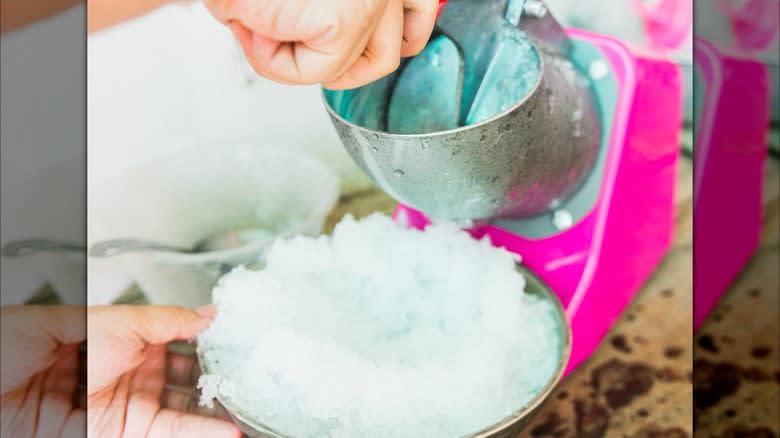
There are generally two ways you can make Hawaiian shaved ice: by hand (the old fashioned way) or with a machine (the more modern method). Back in the day, sugar plantation workers would manually cut their ice blocks with machetes, which would achieve the longer "blades" of ice that this dessert is known for (unlike the finely crushed ice found in snow cones). Later came hand-crank machines, followed by what many shops use today: electric block shavers.
The pros typically use commercial devices, but if you're a Hawaiian shaved ice aficionado, it is possible to purchase shaved ice machines for your home as well -- especially if you're ready to crank out these treats for birthday parties and pool days. They'll likely be too large to fit on your kitchen counter, but you may be able to find a place for them on your patio or in your backyard. If this sounds like too much, you can also buy smaller, cheaper versions that will fit in your kitchen.
These smaller machines typically take ice cubes, while you'll usually need larger ice blocks for the commercial versions. Whichever one you go with, it's important to temper your ice ahead of time so it can shave properly. But if you don't want to shell out extra dough for a new device, we've also rounded up a few tricks for making shaved ice without a fancy machine.
Italian Ice Is Frozen After All The Ingredients Have Been Combined

While Italian ice comes from granita and may fall under the same dessert umbrella as Hawaiian shaved ice, it's even easier to confuse it with sorbet. Both omit dairy completely in favor of sugar, fruit juice, and ice, and both are made by blending these ingredients together. The main difference? Once everything is mixed, sorbet is typically transferred to a loaf pan and placed in the freezer. The unique process for making Italian ice, on the other hand, uses a method similar to that of making ice cream -- the ingredients are combined and frozen in a machine at the same time, which allows air to permeate throughout.
This results in a treat with smaller ice crystals, which makes for a smoother, fluffier, and more scoopable dessert. If you're making Italian ice at home, you don't necessarily need an ice cream maker (although you can use one). You can mimic the results of the commercial devices by freezing your blended mixture in a pan, then taking it out every half hour to stir it and mix air in. If you want to go the extra mile for a smoother texture, you can even transfer it back to the blender after it's frozen and pulverize it again.
Hawaiian Shaved Ice Is Known For Its Toppings
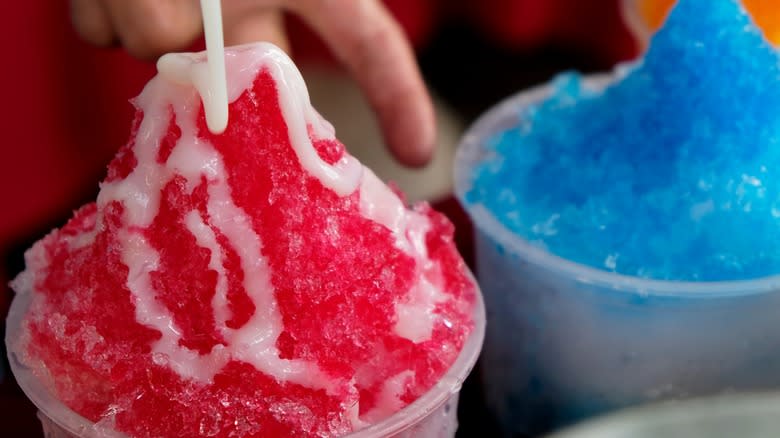
We know that Hawaiian shaved ice has a unique texture, but perhaps the tastiest part of this treat is the toppings, which are as fun as they are varied. One of the most famous locations to find shaved ice on the Hawaiian Islands today is Matsumoto Shave Ice. Here, you'll find more than 1,000 of these treats sold daily with a rainbow of homemade syrups like blue pineapple, sour apple, lychee, liliko'i (passion fruit), pickled mango, and green river -- although the shop's original flavors included root beer, strawberry, and lime. If you're looking to imitate these at home, try combining sugar, water, and a fruit concentrate on the stove, and feel free to store your leftover fruit syrups for future desserts.
But you don't have to stop there. Two classic toppings for Hawaiian shaved ice are adzuki beans, which are made into the sweet red bean paste found in mochi, and sweetened condensed milk. If you want to feel like you're on the Islands in your backyard, use an empty squeeze bottle to apply the latter to create a garnish that's known as a snowcap in Hawaii. Or, take a page out of Matsumoto's book and add on a scoop of vanilla ice cream and mochi balls, then place everything on an edible waffle. And if you're craving a little more freshness, feel free to sprinkle on pineapple chunks, coconut flakes, or sliced strawberries.
You Can Mix And Match Italian Ice Flavors
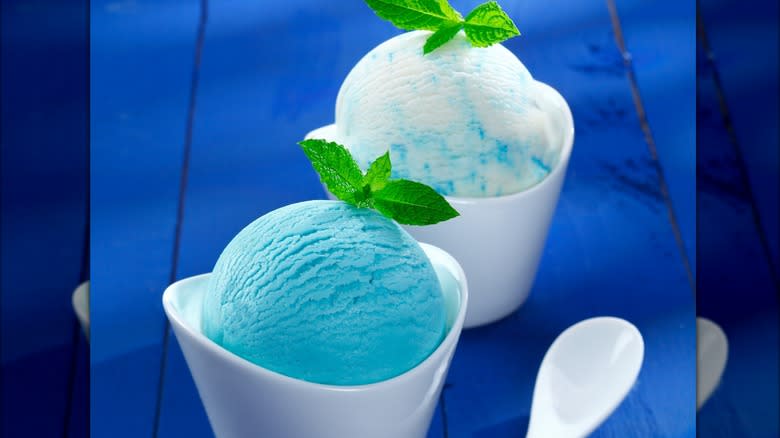
Italian ice typically doesn't go quite as hard on the toppings as Hawaiian shaved ice does -- but only because it blends its flavors into the base instead. You can find Italian ice in a wide array of fruity varieties, including lemon, raspberry, pineapple, blueberry, and strawberry; or a combination of a few different ones, including pineapple coconut and mango melon. To create your own mixture, you'll simply want to incorporate a fruit purée, syrup, or juice, a sweetener like honey or sugar, a dash of lemon juice, and water (or ice, depending on how you're making it).
While the classic version of Italian ice is based on fruity flavors, feel free to experiment with others if you'd like. Rita's, a popular Philadelphia-based shop, sells options such as chocolate, chocolate chip, Dr. Pepper, and Swedish Fish -- so, as long as you don't incorporate dairy, you can still call your creation Italian ice. To make a chocolate version, for example, you'd just replace your fruity ingredients with cocoa powder. But if you really want to upgrade your dessert, try cups that layer custard in between Italian ice, like Rita's does. And while we said this treat doesn't pay much attention to toppings, it can't hurt to garnish with chocolate shavings or a sprig of mint.
Read the original article on Tasting Table.

 Yahoo Finance
Yahoo Finance 